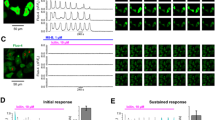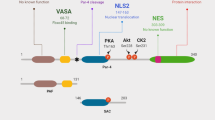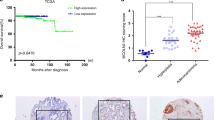Abstract
Although the transient receptor potential melastatin 8 (TRPM8) cold receptor is highly expressed in prostate cancer (PCa) and constitutes a promising diagnostic and prognostic indicator, the natural agonists of this channel in the prostate, as well as its physiological and pathological functions, remain unknown. In this study, we identified the well-known PCa marker, prostate-specific antigen (PSA), as a physiological TRPM8 agonist. Electrophysiological and Ca2+ imaging studies demonstrated that PSA activated TRPM8-mediated current by the bradykinin 2 receptor signaling pathway. Further investigation of this mechanism by cell-surface biotinylation revealed that the increase in TRPM8 current induced by PSA was due to an increase in the number of functional TRPM8 channels on the plasma membrane. Importantly, wound-healing and migration assays revealed that TRPM8 activation by PSA reduced motility of the PC3 PCa cell line, suggesting that plasma membrane TRPM8 has a protective role in PCa progression. Consequently, PSA was identified as a natural TRPM8 agonist in the prostate and we propose a putative physiological role for both of these proteins in carcinogenesis, making this pathway a potentially important target for anticancer agent development.
This is a preview of subscription content, access via your institution
Access options
Subscribe to this journal
Receive 50 print issues and online access
$259.00 per year
only $5.18 per issue
Buy this article
- Purchase on Springer Link
- Instant access to full article PDF
Prices may be subject to local taxes which are calculated during checkout




Similar content being viewed by others
References
Bhoola KD, Figueroa CD, Worthy K . (1992). Bioregulation of kinins: kallikreins, kininogens, and kininases. Pharmacol Rev 44: 1–80.
Bidaux G, Flourakis M, Thebault S, Zholos A, Beck B, Gkika D et al. (2007). Prostate cell differentiation status determines transient receptor potential melastatin member 8 channel subcellular localization and function. J Clin Invest 117: 1647–1657.
Bidaux G, Roudbaraki M, Merle C, Crepin A, Delcourt P, Slomianny C et al. (2005). Evidence for specific TRPM8 expression in human prostate secretory epithelial cells: functional androgen receptor requirement. Endocr Relat Cancer 12: 367–382.
Bindukumar B, Schwartz SA, Nair MP, Aalinkeel R, Kawinski E, Chadha KC . (2005). Prostate-specific antigen modulates the expression of genes involved in prostate tumor growth. Neoplasia 7: 241–252.
Blaukat A . (2003). Structure and signalling pathways of kinin receptors. Andrologia 35: 17–23.
Borgono CA, Diamandis EP . (2004). The emerging roles of human tissue kallikreins in cancer. Nat Rev Cancer 4: 876–890.
Chuang HH, Neuhausser WM, Julius D . (2004). The super-cooling agent icilin reveals a mechanism of coincidence detection by a temperature-sensitive TRP channel. Neuron 43: 859–869.
Cohen P, Graves HC, Peehl DM, Kamarei M, Giudice LC, Rosenfeld RG . (1992). Prostate-specific antigen (PSA) is an insulin-like growth factor binding protein-3 protease found in seminal plasma. J Clin Endocrinol Metab 75: 1046–1053.
Feldman BJ, Feldman D . (2001). The development of androgen-independent prostate cancer. Nat Rev Cancer 1: 34–45.
Gkika D, Prevarskaya N . (2009). Molecular mechanisms of TRP regulation in tumor growth and metastasis. Biochim Biophys Acta 1793: 953–958.
Gkika D, Topala CN, Chang Q, Picard N, Thebault S, Houillier P et al. (2006). Tissue kallikrein stimulates Ca(2+) reabsorption via PKC-dependent plasma membrane accumulation of TRPV5. EMBO J 25: 4707–4716.
Hecquet C, Tan F, Marcic BM, Erdos EG . (2000). Human bradykinin B2 receptor is activated by kallikrein and other serine proteases. Mol Pharmacol 58: 828–836.
Heidtmann HH, Nettelbeck DM, Mingels A, Jager R, Welker HG, Kontermann RE . (1999). Generation of angiostatin-like fragments from plasminogen by prostate-specific antigen. Br J Cancer 81: 1269–1273.
Henshall SM, Afar DE, Hiller J, Horvath LG, Quinn DI, Rasiah KK et al. (2003). Survival analysis of genome-wide gene expression profiles of prostate cancers identifies new prognostic targets of disease relapse. Cancer Res 63: 4196–4203.
Kramarenko II, Bunni MA, Morinelli TA, Raymond JR, Garnovskaya MN . (2009). Identification of functional bradykinin B(2) receptors endogenously expressed in HEK293 cells. Biochem Pharmacol 77: 269–276.
Lilja H . (2003). Biology of prostate-specific antigen. Urology 62: 27–33.
Lilja H, Abrahamsson PA . (1988). Three predominant proteins secreted by the human prostate gland. Prostate 12: 29–38.
Monet M, Gkika D, Lehen'kyi V, Pourtier A, Abeele FV, Bidaux G et al. (2009). Lysophospholipids stimulate prostate cancer cell migration via TRPV2 channel activation. Biochim Biophys Acta 1793: 528–539.
Nelson JB, Hedican SP, George DJ, Reddi AH, Piantadosi S, Eisenberger MA et al. (1995). Identification of endothelin-1 in the pathophysiology of metastatic adenocarcinoma of the prostate. Nat Med 1: 944–949.
Platz EA, Pollak MN, Leitzmann MF, Stampfer MJ, Willett WC, Giovannucci E . (2005). Plasma insulin-like growth factor-1 and binding protein-3 and subsequent risk of prostate cancer in the PSA era. Cancer Causes Control 16: 255–262.
Premkumar LS, Raisinghani M, Pingle SC, Long C, Pimentel F . (2005). Downregulation of transient receptor potential melastatin 8 by protein kinase C-mediated dephosphorylation. J Neurosci 25: 11322–11329.
Robertson SA . (2005). Seminal plasma and male factor signalling in the female reproductive tract. Cell Tissue Res 322: 43–52.
Shah RB, Mehra R, Chinnaiyan AM, Shen R, Ghosh D, Zhou M et al. (2004). Androgen-independent prostate cancer is a heterogeneous group of diseases: lessons from a rapid autopsy program. Cancer Res 64: 9209–9216.
Srinivasan D, Kosaka AH, Daniels DV, Ford AP, Bhattacharya A . (2004). Pharmacological and functional characterization of bradykinin B2 receptor in human prostate. Eur J Pharmacol 504: 155–167.
Thebault S, Lemonnier L, Bidaux G, Flourakis M, Bavencoffe A, Gordienko D et al. (2005). Novel role of cold/menthol-sensitive transient receptor potential melastatine family member 8 (TRPM8) in the activation of store-operated channels in LNCaP human prostate cancer epithelial cells. J Biol Chem 280: 39423–39435.
Tsavaler L, Shapero MH, Morkowski S, Laus R . (2001). Trp-p8, a novel prostate-specific gene, is up-regulated in prostate cancer and other malignancies and shares high homology with transient receptor potential calcium channel proteins. Cancer Res 61: 3760–3769.
Yang ZH, Wang XH, Wang HP, Hu LQ . (2009). Effects of TRPM8 on the proliferation and motility of prostate cancer PC-3 cells. Asian J Androl 11: 157–165.
Zhang L, Barritt GJ . (2006). TRPM8 in prostate cancer cells: a potential diagnostic and prognostic marker with a secretory function? Endocr Relat Cancer 13: 27–38.
Acknowledgements
This study was supported by grants from the Institut national de la Santé et de la Recherche Médicale (INSERM), Ministère de l’éducation nationale and the Ligue Nationale contre le cancer. Dr D Gkika was supported by a grant from the Institut National du Cancer (INCa) (Grant N°: 07/3d1616/pdoc-110-18/ng-nc).
Author information
Authors and Affiliations
Corresponding author
Ethics declarations
Competing interests
The authors declare no conflict of interest.
Additional information
Supplementary Information accompanies the paper on the Oncogene website
Supplementary information
Rights and permissions
About this article
Cite this article
Gkika, D., Flourakis, M., Lemonnier, L. et al. PSA reduces prostate cancer cell motility by stimulating TRPM8 activity and plasma membrane expression. Oncogene 29, 4611–4616 (2010). https://doi.org/10.1038/onc.2010.210
Received:
Revised:
Accepted:
Published:
Issue Date:
DOI: https://doi.org/10.1038/onc.2010.210
Keywords
This article is cited by
-
Sterile inflammation via TRPM8 RNA-dependent TLR3-NF-kB/IRF3 activation promotes antitumor immunity in prostate cancer
The EMBO Journal (2024)
-
TRPM8-androgen receptor association within lipid rafts promotes prostate cancer cell migration
Cell Death & Disease (2019)
-
Encapsulation of a TRPM8 Agonist, WS12, in Lipid Nanocapsules Potentiates PC3 Prostate Cancer Cell Migration Inhibition through Channel Activation
Scientific Reports (2019)
-
Transient receptor potential ion-channel subfamily V member 4: a potential target for cancer treatment
Cell Death & Disease (2019)
-
TRPV1 variants impair intracellular Ca2+ signaling and may confer susceptibility to malignant hyperthermia
Genetics in Medicine (2019)



